First up as usual was Stump the Gurus
with lafcpug regulars Ken
Stone, Andrew
Balis and special Guest Steve
Martin. Some of the questions asked and answered were:
Q. I'm thinking of upgrading to Jaguar.
Should I partition, one for OS9 and one for OSX?
A. Well Jaguar ships with OS9 underneath
so when you install you get both. There are some advantages to
partitioning, one being when you boot up you can old down the
option key and select which partition to boot into. But must
you partition? No.
Q. I get drop frames when I play in to
out on my timeline but get no drop frames if I just play that
section without choosing in to out.
A. Tough one. Could be your machine is
on the edge in terms of keeping up. There are so many reasons.
Also could be drop frames warning could be bogus. Just turn off
the drop frame warning. Doesn't matter if it's really dropping
frames in the timeline. You only really need it when laying off
to tape.
Q. How can I move a whole section of
my timeline and drop it into another section of my timeline and
have stay altogether?
A. Simplest way is to select the section
you want to move and COPY it. Then put your playhead where you
want and select paste.
Next up was FCP Trainer and Guru, Dean Godshall to
talk all about FCP Keyframing which can be a bit daunting
and somewhat murky when first getting started.
Now keyframing is what one does to change
attributes and properties of video and audio over time. Mastering
it and you can do very powerful things.
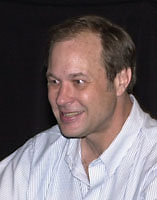 Dean opened up some audio in the viewer and turned
on the timeline overlays to show the audio waveform. By grabbing
the pen tool, Dean marked a few keyframes on various places on
the timeline to begin the process of keyframing. He then selected
one of those keyframes and pulled down, giving an example of
adjusting the audio volume. This is very handy in mixing and
is all done in real time assuming you dont have a gazillion tracks
of audio. Mixing in the timeline can be a bit tough on the eyes
so if you are going to play with your audio, best to do it in
the Viewer. Much bigger and much more control.
Dean opened up some audio in the viewer and turned
on the timeline overlays to show the audio waveform. By grabbing
the pen tool, Dean marked a few keyframes on various places on
the timeline to begin the process of keyframing. He then selected
one of those keyframes and pulled down, giving an example of
adjusting the audio volume. This is very handy in mixing and
is all done in real time assuming you dont have a gazillion tracks
of audio. Mixing in the timeline can be a bit tough on the eyes
so if you are going to play with your audio, best to do it in
the Viewer. Much bigger and much more control.
Dean then took a bit of a side track
to show us a very powerful tool and opened the QuickView window
which many new to FCP 3 forget exists half of the time and showed
how you can make adjustments to transitions, in this case, a
cube spin transition, practically in real time without rendering.
The Quickview will give you a few second preview of your adjustments
almost on the fly as you make them. No stopping to playback to
see what you have just done. Dont like the transition you put
between your clips? Well grab another and drop it in and watch
it go before your very eyes. Talk about a timesaver. Of course
you cant see this on an NTSC monitor but, who cares. Too bad
you can't keyframe transitions.
Dean then dropped a filter onto a high
res picture, still with QuickView opened and keyframed the still
in the Canvas window using the Wireframe overlay and again the
QuickView updated almost instantly. Works on slow machines too
but not as well obviously.
Keyframing filters and picture in picture
and flying objects, etc is a most enjoyable way to learn this
art. No waiting around and you see what you get almost instantly.
More info on keyframing can be found
in this excellent article
by Ken Stone
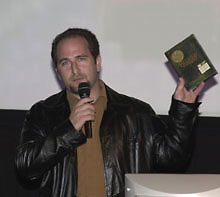 First
show and tell of the night came from Barry Goch,
editor at New Wave Entertainment
who showed us clips from the DVD RollerBall, The Incredible Mr
Limpit, and Clash of the Titans as well as a very groovy sound
design he created in entirely with FCP.
First
show and tell of the night came from Barry Goch,
editor at New Wave Entertainment
who showed us clips from the DVD RollerBall, The Incredible Mr
Limpit, and Clash of the Titans as well as a very groovy sound
design he created in entirely with FCP.
Barry spent time explaining to us the
process of incorporating the many graphics given to him as well
the many instances of why he chose the clips that he did.
These were al very different and excellent
examples of not only work flow but the creative process.
Barry also gave away a 4DVD set of Lord
of the Rings to a lucky person who paid attention to his preso
and answered a question.
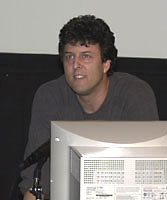 Next
up was one of lafcpugs favorites, Steve
Martin, this time to talk all about the Browser which
on the surface sounds about as exciting as watching an Oprah
rerun, but in the hands of Steve Martin it is very much exciting.
Well, it's at least useful to know how to organize your media
in the browser to keep you sane and thats what Steve was here
to teach us.
Next
up was one of lafcpugs favorites, Steve
Martin, this time to talk all about the Browser which
on the surface sounds about as exciting as watching an Oprah
rerun, but in the hands of Steve Martin it is very much exciting.
Well, it's at least useful to know how to organize your media
in the browser to keep you sane and thats what Steve was here
to teach us.
Now you all know about Bins, right? Well
by option + double clicking on any bin, it will automatically
dock it for you and give you your own tab to work with. Works
with 3.0.2 and above only and very handy. It's called Better
Bins.
You can change the column layout by simply
dragging the column to where you want it to go. Handy if you
want your NOTES column near the beginning and not a half mile
down the layout. You can also SAVE your column layouts into a
separate file anywhere on your Mac to use again and again.
You all know that you can drag a clip
into another bin and it will copy right? Well how about dragging
a clip into another bin where the word "copy" doesn't
appear with your copied clip? Easy, just hold down the option
key, drag the clip to the new bin and let go of the option key
and drop the clip in. No word "copy" at end of clip
file name.
You all know that you can sort the columns,
right? Lets say you went through all your clips and marked the
GOOD takes in the Takes column. By clicking on the top of the
Takes column you can bring all your GOOD clips in mass to the
top. BUT, did you know you can also sort secondary to your primary
sort? Lets say you have all your GOOD clips where you want but
now want to sort by duration in relationship to those GOOD clips.
Easy. Hold down the SHIFT key and click on the duration column.
 The
Find window is very powerful and many dont use it. Use it says
Steve. For example, lets say you want to find all the clips with
the name "John" in the clip name or notes. Bring up
the Find window from the EDIT Menu and type in John and all the
clips with John in the name and notes come up in it's own window.
Lets say you want to show the clip(s) you find in the browser.
Just select the clip in that new window and click on SHOW IN
BROWSER.The clip is highlighted in the browser. Or you can select
several of the John clips and label them a color so all of the
clips are now visible by color in your browser. Cool.
The
Find window is very powerful and many dont use it. Use it says
Steve. For example, lets say you want to find all the clips with
the name "John" in the clip name or notes. Bring up
the Find window from the EDIT Menu and type in John and all the
clips with John in the name and notes come up in it's own window.
Lets say you want to show the clip(s) you find in the browser.
Just select the clip in that new window and click on SHOW IN
BROWSER.The clip is highlighted in the browser. Or you can select
several of the John clips and label them a color so all of the
clips are now visible by color in your browser. Cool.
Steve went on to show us much more, such
as list view, large icon view, etc but space doesn't allow me
to write about it here. For more information on the browser read
the manual or buy this months DVD. It's got great tips and tricks.
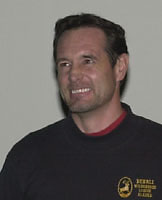 Next
show and tell was from Filmmaker Daniel Foster
of Eye Awake Studio and
it was a exceptionally fine piece of moviemaking titled "Airborne,"
about those strange balloon people you see hovering and flapping
their "arms" above Car dealerships and in front of
Store openings. Heck they're everywhere now it seems.
Next
show and tell was from Filmmaker Daniel Foster
of Eye Awake Studio and
it was a exceptionally fine piece of moviemaking titled "Airborne,"
about those strange balloon people you see hovering and flapping
their "arms" above Car dealerships and in front of
Store openings. Heck they're everywhere now it seems.
Expertly shot on DV and narrated by Daniel
with soundtrack by Moby and effects by FCP and Studio Artist
it is surprisingly touching for all of it's silliness. This one
should be seen, not written about.
Twas gobs of info to absorb so we all
wandered out into the lobby for a break to visit with
each other and gaze upon the groovy toys Promax brought to show
off.
Larry
Jordan, a favorite now of lafcpug
was up next to continue on the theme of making things move in
FCP and make them move in the way you want them to move.
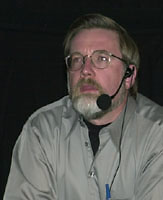 Larry
covered pans, tilts, zooms and dissolves on still images to create
the
Larry
covered pans, tilts, zooms and dissolves on still images to create
the
illusion of movement (i.e. Ken Burns) and so much more.
Lets start with image size why dont we.
Here are the rules folks. Ain't no getting around them.
1. All images are 72dpi
2. NTSC DV Image size: 720x480
3. NTSC Beta image size: 720x486
PAL DV image size: 720x 576
HD 720i/p image size: 1280x720
HD 1080i/p image size: 1920x1080
However these numbers dont work if you're
creating graphics in say, Photoshop for import into FCP. More
on that go here.
Larry says "figure out what you
want to do, scan your image in RGB color space, set resolution
to 72dpi and use 24bit color, import into FCP, create your movement,
THEN add transitions, and THEN filters and color tweaks."
Got it?
Larry then brought up a photo to pan
left to right and, remember since we scanned the pic at 72dpi
we got lots of resolution left to make this pic wider or longer
and not mess with the resolution quality. Larry likes simply
to multiply the width or height or both by a factor of 1, 2 or
3 if you want to zoom, or Pan. By golly it works.
Larry then went into showing us actually
HOW to pan and scan using keyframes and you can get the jist
of that here.
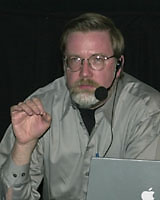 Larry
then finished off with a small project that showcased what he'd
just spent 30 minutes talking about.
Larry
then finished off with a small project that showcased what he'd
just spent 30 minutes talking about.
To sum up here are Larry's Top Tips for
making things move in FCP:
-- Resolution is ALWAYS 72 dpi
-- Ignore resolution -- count pixels
-- Correct for non-square pixels
-- Set color to RGB, let FCP convert
-- Zooming into 100% images pixelate
-- Images must be larger than screen size for moves
-- Use ease-in/ease-out for slow moves
-- Continue moves thru dissolves
-- Try to avoid creating whiplash
-- Don't overuse key frames
-- Preview transitions using QuickView to save time
-- Give yourself permission to experiment!
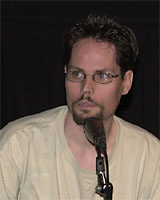 Last
show and tell of the night was from filmmaker Scott
Peterson who showed us a clip from his upcoming documentary
on professional Scrabble players with the apt name, "Scrabylon"
Last
show and tell of the night was from filmmaker Scott
Peterson who showed us a clip from his upcoming documentary
on professional Scrabble players with the apt name, "Scrabylon"
This particular clip follows a scrabble
player named GI Joel who has a myriad of diseases related to
his Gastro Intestinal tract. He's the kind of guy who shouldn't
be playing scrabble yet does.
Shot with a VX1000 and XL1 using available
light it takes us deep into the world of tournament Scrabble
and it's a lot more interesting than one would think.
World Famous Raffle was up next and lafcpug thanks the following
for their generosity.
2 FCP Keyboard Keycharts
- Neotron
Design
2 Royalty Free
Stock Footage CDs - ThinkStock
3 OSX T-Shirts
- Apple
Computer
1 copy of Peak
3.1 - Bias-Inc
2 Boxes of Pencils with an Apple logo on them -Apple Computer (Grand Prize)
Free FCP 101 class - Digital
FilmTree
5 $20.00 Gift Certificates - Poquito Mas Restaurants (Hey, we gotta eat)
DV Companion for FCP 3 - Intelligent
Assistance
TroubleShooter
for Final Cut Pro - Intelligent
Assistance
2 Royalty Free Stock Footage
Cds - RocketClips
DVD Companion Pro Pack -
Recipe
4 DVD
1 copy Audio Postproduction
for Digital Video - CMP
Books
2 copies "Color
Correction for Digital Video" - CMP
Books
2 copies "Producing
Great Sound For Digital Video" - CMP
Books
1 T-shirt - kenstone.net
Special thanks must go to Chris
Rogers, for taking tickets. Ken stone for taking pics. Mark Havener for doing
the lights and Dan Brockett
for taping the show, and of course Promax for footing the bill.
Michael Horton,
"HeadCutter"